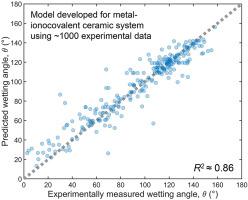Journal of Materiomics ( IF 8.4 ) Pub Date : 2021-03-31 , DOI: 10.1016/j.jmat.2021.03.014 So Yeon Kim , Ju Li

|
The adhesion and wetting between metal and ceramic is a basic problem in materials science and engineering. For example, past materials selection for metal-ceramic composites has relied on random trials and heuristics due to a limited understanding of their adhesion; the large chemical/structural variability that such interfaces can have hinders the identification of the governing factors. Here based on literature data, we have developed a database with ∼1,000 experimentally measured wetting angles at different temperatures and atmospheric conditions, and come up with a model for the wettability of ionocovalent ceramics (ICs) by metals using a machine learning (ML) algorithm. The random forest model uses the testing temperature and ∼40 features generated based on the chemical compositions of the metal and the ceramic as predictors and exhibits strong predictive power with an R2 of ∼0.86. Moreover, this model and the featurization code are integrated into a single computational pipeline to enable (1) predicting metal-IC wettability of interest and (2) high-throughput searching of ICs with the desired wettability by certain metals in the entire Inorganic Crystallographic Structure Database. As a demonstration of this pipeline, the wettability of a Li-ion and electron insulator (LEI), CaO, by molten Li is estimated and compared with ab initio molecular dynamics simulation result. This ML pipeline can serve as a practical tool for methodical design of materials in systems where certain metal-ceramic wettability is desired.
中文翻译:

金属陶瓷润湿性的机器学习
金属与陶瓷之间的粘附和润湿是材料科学与工程中的一个基本问题。例如,过去金属陶瓷复合材料的材料选择由于对其粘附性的了解有限而依赖于随机试验和启发式方法;这种界面可能具有的巨大的化学/结构可变性阻碍了控制因素的识别。在此基于文献数据,我们开发了一个数据库,其中包含 1,000 个在不同温度和大气条件下实验测量的润湿角,并使用机器学习 (ML) 算法提出了金属对离子共价陶瓷 (IC) 的润湿性模型.R 2为~0.86。此外,该模型和特征化代码被集成到单个计算管道中,以实现 (1) 预测感兴趣的金属 IC 润湿性和 (2) 高通量搜索具有特定金属在整个无机晶体结构中所需润湿性的 IC数据库。作为该管道的演示,评估了熔融锂对锂离子和电子绝缘体 (LEI) CaO 的润湿性,并与从头算分子动力学模拟结果进行了比较。这种 ML 管道可以作为一种实用工具,用于在需要某些金属-陶瓷润湿性的系统中进行材料的有条不紊设计。











































 京公网安备 11010802027423号
京公网安备 11010802027423号